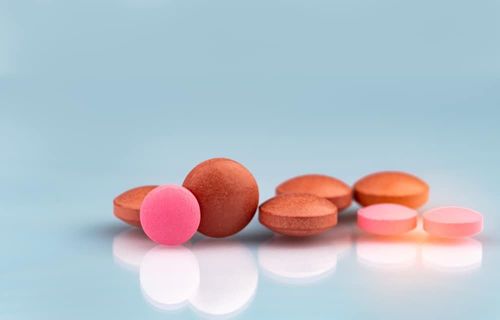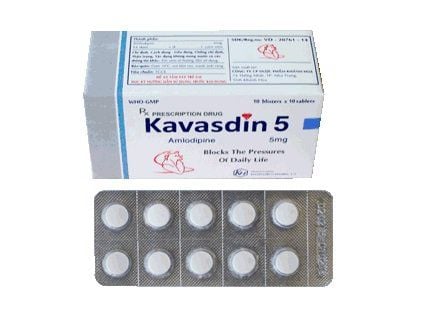This is an automatically translated article.
Amlodipine TV is usually used primarily to treat high blood pressure or stable angina. Patients need to follow the treatment plan recommended by the doctor to ensure that Amlodipine TV is safe and effective.1. Amlodipine TV drug uses and indications
The main active ingredient Amlodipine in TV medicine Amlodipine acts as a synthetic dihydropyridine that performs the function of blocking calcium channels, helping to inhibit the influx of extracellular calcium ions to vascular, cardiac and peripheral smooth muscle cells. Through this mechanism, Amlodipine can dilate coronary arteries and increase oxygenated blood flow to the myocardium, thereby helping to prevent vasospasm and hypertension.
Currently, the TV drug Amlodipine is known as a long-acting calcium channel blocker, commonly used to treat conditions such as angina and hypertension. The active ingredient Amlodipine in the drug works to improve blood pressure levels by relaxing smooth muscle in the artery walls and reducing peripheral resistance. Besides, angina is also significantly relieved because Amlodipine helps increase blood flow to the heart muscle, thereby preventing diseases caused by coronary arteries.
TV Amlodipine is commonly prescribed by doctors to treat the following conditions:
Treatment of high blood pressure and stable angina attacks. Treatment of vasospasm, coronary heart disease and stroke. Do not arbitrarily use TV Amlodipine for the following subjects without a doctor's prescription:
Patients with decompensated heart failure, aortic stenosis and cardiogenic shock. The patient has heart failure but has not been treated stably. Patients with a history of allergy or hypersensitivity to Amlodipine or any of the excipients.
2. Dosage and how to use TV Amlodipine
2.1 Dosage of TV drug Amlodipine Treatment dose for hypertension:
Initial dose: Take 5mg / time / day (corresponding to 1 tablet). Maintenance dose: Take 5-10mg / time / day (corresponding to 1-2 tablets). For people with weak or thin health, they should only take 1 tablet per day and always monitor their health during treatment. Dosage for coronary heart disease and angina pectoris:
Dose for chronic angina in people without heart failure: Take from 5 to 10mg / time / day. Dose for people with chronic angina due to vasoconstriction: Use dose 10mg / time / day. 2.2 Guidelines for effective use of TV Amlodipine TV Amlodipine is in the form of hard capsules that should be taken orally. Because the drug is not affected by food, patients can take Amlodipine TV with or after meals.
Should take Amlodipine TV regularly every day as prescribed by the doctor, avoid arbitrarily skipping dose, increasing or decreasing the dose. Increasing the dose of TV Amlodipine can lead to overdose toxicity. When this happens, the patient needs to quickly go to the doctor for treatment.
Usually, TV Amlodipine overdose will be resolved by treating the cardiovascular symptoms, adjusting electrolytes, monitoring the heart with electrocardiogram and taking activated charcoal. If heart block or bradycardia occurs, the patient should be given intravenous atropine 0.5 to 1 mg. In case of overdose with hypovolaemia, the patient will be infused with 0.9% sodium chloride solution, even put on a pacemaker if necessary. When blood pressure is severely lowered, it is necessary to quickly treat the patient by intravenously injecting 0.9% sodium chloride solution. If no improvement can be used in combination with Isoprenalin with Amrinon.
3. Possible side effects when treated with TV Amlodipine
Below are some of the side effects that may occur when taking TV Amlodipine , including:
Mild to moderate ankle swelling. Feeling hot in the face. Cramp. Shortness of breath . Headache. Tired . Attenuate. Stomachache. Chest palpitations. Undigested. Nausea or vomiting. Muscle pain. Chest pain. Excessive lowering of blood pressure. Athritis. Sleep disorders . Fast heart beat. If during treatment, the patient notices any adverse effects appear, promptly notify the doctor for support.
4. What should be done to take Amlodipine TV safely?
To use Amlodipine TV drug safely and effectively, patients should note a few things below:
Do not use alcohol or other alcoholic beverages because they can lower blood pressure and increase blood pressure. drug side effects. Amlodipine TV should only be used in children over 6 years of age. Amlodipine TV should be used with caution in patients with heart failure after acute myocardial infarction, aortic stenosis and liver failure. While taking the drug, you need to adopt a healthy, reasonable diet to keep your blood pressure under control. Always read the instructions for use carefully before treating with TV Amlodipine. The shelf life of Amlodipine TV is 36 months from the date of manufacture indicated on the package. Patients should avoid taking expired, deformed, or distorted medications. Amlodipine TV drug when used during pregnancy can reduce fetal perfusion leading to oxygen deficiency to the fetus. Therefore, doctors often recommend that pregnant women, especially the first 3 months, avoid taking Amlodipine TV. There is no specific information on the accumulation of Amlodipine in breast milk. Therefore, women who are breastfeeding should consult a doctor before using the drug.
5. Amlodipine TV can interact with any drugs?
You need to be careful when combining the use of TV Amlodipine with the following drugs:
Drugs that are highly bound to plasma proteins. Anesthesia can cause a serious drop in blood pressure when taken with Amlodipine. Non-steroidal anti-inflammatory drugs (NSAIDs), typically Indomethacin, may interfere with the antihypertensive effect of the TV drug Amlodipine. Lithium drugs can cause diarrhea, neurotoxicity, nausea and vomiting when used together with Amlodipine TV.
Please dial HOTLINE for more information or register for an appointment HERE. Download MyVinmec app to make appointments faster and to manage your bookings easily.













